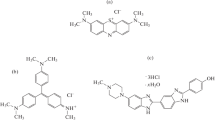Abstract
It is significant to quantify the intermolecular physisorption extent in biomedical field. By taking the advantage of a significant difference from either sizes or weights, we introduced a combination of Scatchard equation and either ultracentrifugation or size exclusion chromatography to obtain both the binding constant and the number of binding sites by using bovine serum albumin and eosin B as models. Compared to the photoluminescence quenching-based methods like Stern–Volmer and Hill equations, the introduced method is not only more precise but also simpler and more straightforward for the operation. Moreover, the protein conformational changes and the corresponding theoretical binding mode with an atomic resolution were also studied by using three-dimensional fluorescence spectroscopy and molecular docking method, respectively. These comparative results could help scientists select right methods to study any interactions between two molecules with significant differences from either sizes or weights.





Similar content being viewed by others
References
J. Guo, R.B. Zhong, W.R. Li et al., Interaction study on bovine serum albumin physically binding to silver nanoparticles: evolution from discrete conjugates to protein coronas. Appl. Surf. Sci. 359, 82 (2015). doi:10.1016/j.apsusc.2015.09.247
R.B. Zhong, M. Yuan, H.Y. Gao et al., A subtle calculation method for nanoparticle’s molar extinction coefficient: the gift from discrete protein-nanoparticle system on agarose gel electrophoresis. Funct. Mater. Lett. 9, 1650029 (2016). doi:10.1142/S1793604716500296
Y.S. Liu, R.B. Zhong, P. Zhang et al., Understanding the robust physisorption between bovine serum albumin and amphiphilic polymer coated nanoparticles. ACS Appl. Mater. Interfaces 8, 2478 (2016). doi:10.1021/acsami.5b08386
R.B. Zhong, Y.S. Liu, P. Zhang et al., Discrete nanoparticle-BSA conjugates manipulated by hydrophobic interaction. ACS Appl. Mater. Interfaces 6, 19465 (2014). doi:10.1021/Am506497s
T.G. Drummond, M.G. Hill, J.K. Barton, Electrochemical DNA sensors. Nat. Biotechnol. 21, 1192 (2003). doi:10.1038/nbt873
P. Wang, R.B. Zhong, M. Yuan et al., Mercury (II) detection by water-soluble photoluminescent ultra-small carbon dots synthesized from cherry tomatoes. Nucl. Sci. Tech. 27, 35 (2016). doi:10.1007/s41365-016-0038-1
Z.J. Bai, Y.S. Liu, P. Zhang et al., Fluorescence resonance energy transfer between bovine serum albumin and fluoresceinamine. Luminescence 31, 688 (2016). doi:10.1002/bio.3012
M. Yuan, R.B. Zhong, X.L. Yun et al., A fluorimetric study on the interaction between a Trp-containing beta-strand peptide and amphiphilic polymer-coated gold nanoparticles. Luminescence 31, 47 (2016). doi:10.1002/bio.2920
R.B. Zhong, Y.S. Liu, P. Zhang et al., A facile method to build a proton nanosensor with neutral to basic pH sensitive range. Nucl. Sci. Tech. 25, 040503 (2014). doi:10.13538/j.1001-8042/nst.25.040503
M. Yuan, R.B. Zhong, H.Y. Gao et al., One-step, green, and economic synthesis of water-soluble photoluminescent carbon dots by hydrothermal treatment of wheat straw, and their bio-applications in labeling, imaging, and sensing. Appl. Surf. Sci. 355, 1136 (2015). doi:10.1016/j.apsusc.2015.07.095
Y.S. Liu, P. Zhang, R.B. Zhong et al., Fluorimetric study on the interaction between fluoresceinamine and bovine serum albumin. Nucl. Sci. Tech. 26, 030505 (2015). doi:10.13538/j.1001-8042/nst.26.030505
K. Matsumoto, B.D.B. Tiu, A. Kawamura et al., QCM sensing of bisphenol A using molecularly imprinted hydrogel/conducting polymer matrix. Polym. J. 48, 525 (2016). doi:10.1038/pj.2016.23
G.S. Huang, M.T. Wang, M.Y. Hong, A versatile QCM matrix system for online and high-throughput bio-sensing. Analyst 131, 382 (2006). doi:10.1039/b515722f
R.B. Towery, N.C. Fawcett, P. Zhang et al., Genomic DNA hybridizes with the same rate constant on the QCM biosensor as in homogeneous solution. Biosens. Bioelectron. 16, 1 (2001). doi:10.1016/S0956-5663(00)00126-3
H.A. Atwater, A. Polman, Plasmonics for improved photovoltaic devices. Nat. Mater. 9, 205 (2010). doi:10.1038/nmat2629
J.N. Anker, W.P. Hall, O. Lyandres et al., Biosensing with plasmonic nanosensors. Nat. Mater. 7, 442 (2008). doi:10.1038/nmat2162
F. Leo, A. Magistrato, D. Bonifazi, Interfacing proteins with graphitic nanomaterials: from spontaneous attraction to tailored assemblies. Chem. Soc. Rev. 44, 6916 (2015). doi:10.1039/c5cs00190k
A.C. Newton, J. Groenewold, W.K. Kegel et al., Rotational diffusion affects the dynamical self-assembly pathways of patchy particles. Proc. Natl. Acad. Sci. USA 112, 15308 (2015). doi:10.1073/pnas.1513210112
Y.X. Ma, R.B. Zhong, J. Guo et al., A facile method for studying interaction of rhodamine B and bovine serum albumin: towards physical-binding mediated fluorescence labeling of proteins. Nucl. Sci. Tech. 26, 060502 (2015). doi:10.13538/j.1001-8042/nst.26.060502
D. Stefanovic, M. Stefanovic, D. Lalosevic, Use of eriochrome cyanine R in routine histology and histopathology: is it time to say goodbye to hematoxylin? Biotech. Histochem. 90, 461 (2015). doi:10.3109/10520295.2015.1057765
A.A. Waheed, K.S. Rao, P.D. Gupta, Mechanism of dye binding in the protein assay using eosin dyes. Anal. Biochem. 287, 73 (2000). doi:10.1006/abio.2000.4793
A.A. Waheed, P.D. Gupta, Single-step method for estimating nanogram quantities of protein. Anal. Biochem. 275, 124 (1999). doi:10.1006/abio.1999.4301
L.L. He, X.X. Wu, Y.X. Wang et al., Spectroscopic investigation on the sonodynamic damage to protein in the presence of eosine B. Ultrason. Sonochem. 26, 93 (2015). doi:10.1016/j.ultsonch.2015.02.002
A.A. Waheed, P.D. Gupta, Estimation of submicrogram quantities of protein using the dye eosin Y. J. Biochem. Biophys. Methods 42, 125 (2000). doi:10.1016/S0165-022X(99)00055-X
J.R. Lakowicz, Principles of Fluorescence Spectroscopy, 3rd edn. (Springer, New York, 2006)
A. Grinvald, I.Z. Steinberg, The fluorescence decay of tryptophan residues in native and denatured proteins. Biochim. Biophys. Acta 427, 663 (1976). doi:10.1016/0005-2795(76)90210-5
H.H. Sun, J. Zhang, Y.Z. Zhang et al., Interaction of human serum albumin with 10-hydroxycamptothecin: spectroscopic and molecular modeling studies. Mol. Biol. Rep. 39, 5115 (2012). doi:10.1007/s11033-011-1307-z
Author information
Authors and Affiliations
Corresponding author
Additional information
This work was supported by the National Natural Science Foundation of China (Nos. 21171086 and 81160213), the Inner Mongolia Autonomous Region science and Technology Department (No. 211-202077), the Inner Mongolia Grassland Talent (No. 108-108038), the Natural Science Foundation of Inner Mongolia Autonomous Region of China (Nos. 2013MS1121, 2015ms0806 and 2016MS0211) and the Inner Mongolia Agricultural University (Nos. 109-108040, 211-109003 and 211-206038).
Rights and permissions
About this article
Cite this article
Li, WR., Gong, P., Ma, YX. et al. A facile and precise method for quantifying small–large/light-weighted molecular interaction system. NUCL SCI TECH 27, 109 (2016). https://doi.org/10.1007/s41365-016-0123-5
Received:
Revised:
Accepted:
Published:
DOI: https://doi.org/10.1007/s41365-016-0123-5




